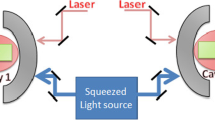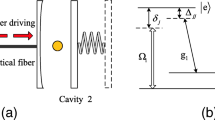Abstract
In this paper, we propose a scheme to generate an entangled state between two spatially separated movable mirrors by injecting the two-mode squeezed optical reservoir to the dissipative optomechanics, in which the movable mirrors can modulate the linewidth of the cavity modes. When the coupling between the mirrors and the corresponding cavity modes is weak, the two driven cavity fields can respectively behave as the squeezed-vacuum reservoir for the two movable mirrors by utilizing the effect of completely destructive interference of quantum noise. Thus the mechanical modes are prepared in a two-mode squeezed vacuum state. Moreover, when the coupling between the two mirrors and the cavities modes is strong, the entanglement between the two movable mirrors decreases because photonic excitation can preclude the completely destructive interference of quantum noise, but the movable mirrors are still entangled.
Similar content being viewed by others
References
Gigan S, Böhm H R, Paternostro M, et al. Self-cooling of a micromirror by radiation pressure. Nature, 2006, 444: 67–70
Arcizet O, Cohadon P F, Briant T, et al. Radiation-pressure cooling and optomechanical instability of a micromirror. Nature, 2006, 444: 71–74
Liu Y C, Xiao Y F, Luan X S, et al. Dynamic dissipative cooling of a mechanical resonator in strong coupling optomechanics. Phys Rev Lett, 2013, 110: 153606
Xiong H, Si L G, Lu X Y, et al. Carrier-envelope phase-dependent effect of high-order sideband generation in ultrafast driven optomechanical system. Opt Lett, 2013, 38: 353
Guo Y J, Li K, Nie W J, et al. Electromagnetically-induced-transparency-like ground-state cooling in a double-cavity optomechanical system. Phys Rev A, 2014, 90: 053841
Wang H, Gu Y, Liu Y X, et al. Optomechanical analog of two-color electromagnetically induced transparency: Photon transmission through an optomechanical device with a two-level system. Phys Rev A, 2014, 90: 023817
Chen B, Jiang C, Li J J, et al. All-optical transistor based on a cavity optomechanical system with a Bose-Einstein condensate. Phys Rev A, 2011, 84: 055802
Dong C H, Fiore V, Kuzyk M C, et al. Optomechanical dark mode. Science, 2012, 338: 1609
Gorodetksy M L, Schliesser A, Anetsberger G, et al. Determination of the vacuum optomechanical coupling rate using frequency noise calibration. Opt Express, 2010, 18: 23236–23246
Fu H, Mao T H, Li Y, et al. Optically mediated spatial localization of collective modes of two coupled cantilevers for high sensitivity optomechanical transducer. Appl Phy Lett, 2014, 105: 014108
Abramovici A, Althouse WE, Drever RWP, et al. LIGO: The laser interferometer gravitational-wave observatory. Science, 1992, 256: 325–333
Ma Y Q, Danilishin S L, Zhao C N, et al. Narrowing the Filter-cavity bandwidth in gravitational-wave Detectors via optomechanical interaction. Phys Rev Lett, 2014, 113: 151102
Vitali D, Mancini S, Tombesi P, et al. Optomechanical scheme for the detection of weak impulsive forces. Phys Rev A, 2004, 64: 051401
Dong C H, Shen Z, Zou C L, et al. Interconversion of photon-phonon in a silica optomechanical microresonator. Sci China-Phy Mech Astron, 2015, 58: 050308
Liu Y C, Xiao Y F, Chen Y L, et al. Parametric down-conversion and Polariton pair generation in optomechanical systems. Phys Rev Lett, 2013, 111: 083601
Habraken S J M, Lechner W, Zoller P, et al. Resonances in dissipative optomechanics with nanoparticles: Sorting, speed rectification, and transverse cooling. Phys Rev A, 2013, 87: 053808
Elste F, Girvin S M, Clerk A A, et al. Quantum noise interference and backaction cooling in cavity nanomechanics. Phys Rev Lett, 2009, 102: 207209
Braginsky V B, Strigin S E, Vyatchanin S P, et al. Parametric oscillatory instability in Fabry-Perot interferometer. Phys Lett A, 2001, 287: 331–338
Schliesser A, DelHaye P, Nooshi N, et al. Radiation pressure cooling of a micromechanical oscillator using dynamical backaction. Phys Rev Lett, 2006, 97: 243905
Wilson-Rae I, Nooshi N, Zwerger W, et al. Theory of ground state cooling of a mechanical oscillator using dynamical backaction. Phys Rev Lett, 2007, 99: 093901
Teufel J D, Donner T, Li Dale, et al. Sideband cooling of micromechanical motion to the quantum ground state. Nature, 2011, 475: 359–363
Safavi-Naeini A H, Chan J. Observation of quantum motion of a nanomechanical resonator. Phys Rev Lett, 2012, 108: 033602
Zhang P, Wang Y D, Sun C P, et al. Cooling mechanism for a nanomechanical resonator by periodic coupling to a cooper pair box. Phys Rev Lett, 2005, 95: 097204
Wang X T, Vinjanampathy S, Strauch F W, et al. Ultraefficient cooling of resonators: Beating sideband cooling with quantum control. Phys Rev Lett, 2011, 107: 177204
Xia K Y, Evers J. Ground state cooling of a nanomechanical resonator in the nonresolved regime via quantum interference. Phys Rev Lett, 2009, 103: 227203
Rabl P, Cappellaro P, Gurudev Dutt M V, et al. Strong magnetic coupling between an electronic spin qubit and a mechanical resonator. Phys Rev B, 2009, 79: 041302
Zhang J Q, Zhang S, Zou J H, et al. Fast optical cooling of nanomechanical cantilever with the dynamical Zeeman effect. Opt Express, 2013, 21: 29695–29710
Genes C, Ritsch H, Drewsen M, et al. Atom-membrane cooling and entanglement using cavity electromagnetically induced transparency. Phys Rev B, 2011, 84: 051801
Morigi G, Eschner J, Keitel C H, et al. Ground state laser cooling using electromagnetically induced transparency. Phys Rev Lett, 2000, 85: 4458–4461
Evers J, Keitel C H. Double-EIT ground-state laser cooling without blue-sideband heating. Europhys Lett, 2000, 68: 370–376
Schmidt-Kaler F, Eschner J, Morigi G, et al. Laser cooling with electromagnetically induced transparency: Application to trapped samples of ions or neutral atoms. Appl Phys B, 2001, 73: 807–814
Fleischhauer M, Imamoglu A, Marangos J P, et al. Electromagnetically induced transparency: Optics in coherent media. Rev Mod Phys, 2005, 77: 633–673
Zhang S, Zhang J Q, Zhang J, et al. Ground state cooling of an optomechanical resonator assisted by a λ-type atom. Opt Express, 2014, 22: 28118–28131
Xuereb A, Schnabel R, Hammerer K, et al. Dissipative optomechanics in a Michelson-Sagnac interferometer. Phys Rev Lett, 2011, 107: 213604
Brooks D W C, Botter T, Schreppler S, et al. Non-classical light generated by quantum-noise-driven cavity optomechanics. Nature, 2012, 488: 476–480
Safavi-Naeini A H, Gröblacher S, Hill J T, et al. Squeezed light from a silicon micromechanical resonator. Nature, 2012, 500: 185–189
Purdy T P, Yu P L, Peterson R W, et al. Strong optomechanical squeezing of light. Phys Rev X, 2013, 3: 031012
Clerk A A, Marquardt F, Jacobs K, et al. Back-action evasion and squeezing of a mechanical resonator using a cavity detector. New J Phys, 2008, 10: 095010
Ian H, Gong Z R, Liu Y X, et al. Cavity optomechanical coupling assisted by an atomic gas. Phys Rev A, 2008, 78: 013824
Jähne K, Genes C, Hammerer K, et al. Cavity-assisted squeezing of a mechanical oscillator. Phys Rev A, 2009, 79: 063819
Farace A, Giovannetti V. Enhancing quantum effects via periodic modulations in optomechanical systems. Phys Rev A, 2012, 86: 013820
Rogers B, Paternostro M, Palma G M, et al. Entanglement control in hybrid optomechanical systems. Phys Rev A, 2012, 86: 042323
Gu W J, Li G X. Squeezing of the mirror motion via periodic modulations in a dissipative optomechanical system. Opt Express, 2013, 21: 20423–20440
Vitali D, Gigan S, Ferreira A, et al. Optomechanical entanglement between a movable mirror and a cavity field. Phys Rev Lett, 2007, 98: 030405
Wang Y D, Clerk A A. Reservoir-engineered entanglement in optomechanical systems. Phys Rev Lett, 2013, 110: 253601
Abdi M, Pirandola S, Tombesi P, et al. Entanglement swapping with local certification: Application to remote micromechanical resonators. Phys Rev Lett, 2012, 109: 143601
Kuzyk M C, Enk S J V, Wang H, et al. Generating robust optical entanglement in weak-coupling optomechanical systems. Phys Rev A, 2013, 88: 062341
Wang C, He L Y, Zhang Y, et al. Complete entanglement analysis on electron spins using quantum dot and microcavity coupled system. Sci China-Phy Mech Astron, 2013, 56: 2054–2058
Liu Y M. Virtual-photon-induced entanglement with two nitrogenvacancy centers coupled to a high-Q silica microsphere cavity. Sci China-Phy Mech Astron, 2014, 56: 2138–2142
Nie W J, Lan Y H, Li Y, et al. Generating large steady-state optomechanical entanglement by the action of Casimir force. Sci China-Phy Mech Astron, 2013, 57: 2276–2284
Mancini S, Giovannetti V, Vitali D, et al. Entangling macroscopic oscillators exploiting radiation pressure. Phys Rev Lett, 2002, 88: 120401
Pinard M, Dantan A, Vitali D, et al. Entangling movable mirrors in a double-cavity system. Europhys Lett, 2005, 72: 747–753
Niedenzu W, Sandner R M, Genes C, et al. Quantum-correlated motion and heralded entanglement of distant optomechanically coupled objects. JPB-At Mol Opt Phys, 2012, 45: 245501
Gu W J, Li G X, Yang Y P, et al. Generation of squeezed states in a movable mirror via dissipative optomechanical coupling. Phys Rev A, 2013, 88: 013835
Weiss T, Bruder C, Nunnenkamp A, et al. Strong-coupling effects in dissipatively coupled optomechanical systems. Rev Mod Phys, 2010, 82: 1155
Aloufi K, Bougouffa S, Ficek Z, et al. Dynamics of entangled states in squeezed reservoirs. arXiv:1403.3892
Weiss T, Nunnenkamp A. Quantum limit of laser cooling in dispersively and dissipatively couped optomechanical systems. Phys Rev A, 2013, 88: 023850
Gardiner C, Zoller P. Quantum Noise: A Handbook of Markovian and Non-Markovian Quantum Stochastic Methods with Applications to Quantum Optics. New York: Springer, 2000
Xiong H, Si L G, Lv X Y, et al. Review of cavity optomechanics in the weak-coupling regime: From linearization to intrinsic nonlinear interactions. Sci China-Phy Mech Astron, 2015, 58: 050302
Tanaś R, Ficek Z. Stationary two-atom entanglement induced by noclassical two-photon correlations. J Opt B-Quantum Semicl Opt, 2004, 6: S610–S617
Scully M O, Zubairy M S. Quantum Optics. Cambridge: Cambrige University Press, 1997
Schumaker B L, Caves C M. New formalism for two-photon quantum optics. II. Mathematical foundation and compact notation. Phys Rev A, 1985, 31: 3093–3111
Reid M D, Drummond P D, Bowen W P, et al. The Einstein-Podolsky-Rosen paradox: From concepts to applications. Rev Mod Phys, 2009, 81: 1727
Giovannetti V, Mancini S, Tombesi P, et al. Radiation pressure induced Einstein-Podolsky-Rosen paradox. Europhys Lett, 2001, 54: 559–565
Duan L M, Giedke G, Cirac J I, et al. Inseparability criterion for continuous variable systems. Phys Rev Lett, 2000, 84: 2722–2725
Sawadsky A, Kaufer H, Nia R M, et al. Observation of generalized optomechanical coupling and cooling on cavity resonance. Phys Rev Lett, 2015, 114: 043601
Author information
Authors and Affiliations
Corresponding author
Rights and permissions
About this article
Cite this article
Yan, Y., Gu, W. & Li, G. Entanglement transfer from two-mode squeezed vacuum light to spatially separated mechanical oscillators via dissipative optomechanical coupling. Sci. China Phys. Mech. Astron. 58, 1–8 (2015). https://doi.org/10.1007/s11433-015-5647-x
Received:
Accepted:
Published:
Issue Date:
DOI: https://doi.org/10.1007/s11433-015-5647-x




